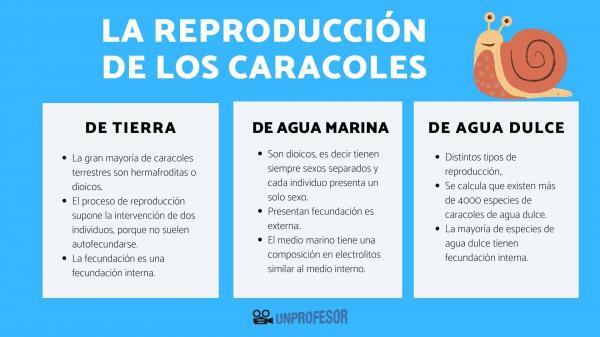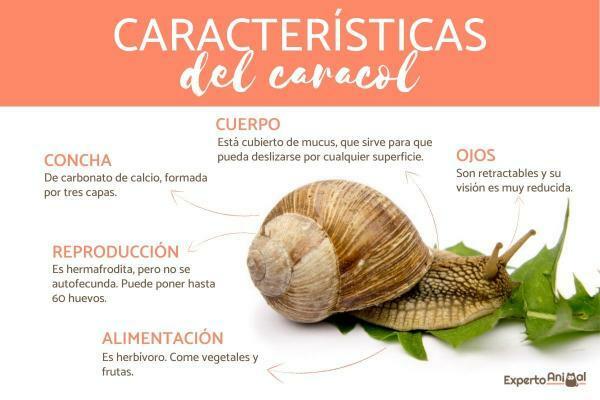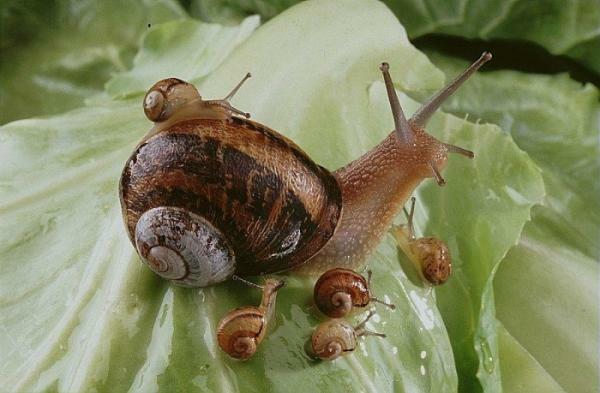Discover how SNAILS REPRODUCE

Snails are really curious animals, if we look at their appearance, this could not be more surprising: the shell they carry to the back, their retractable antennae, their way of moving on a carpet of mucus that they themselves produce ...
If all this seems strange to you, wait to read this lesson from a PROFESSOR in which we tell you how snails reproduce. The reproduction of these animals is undoubtedly a source of surprises. Try it for yourself!
Before telling you how snails reproduce, we are going to make a brief introduction to this animal. Here is a list with characteristics and curiosities of snails:
- The snails (common name by which the gastropods that have a spiral shell) reproduce by sexual reproduction. That is, by merging gametes (reproductive cells) of different sex (eggs and sperm).
- They are animals oviparous: They lay eggs in the external environment in which the embryo develops. Once their development is complete, the eggs hatch releasing the new individual.
- Apart from these two general features, the reproduction of snails is very diverse, since there are a number very high number of snail species and that come from different evolutionary lines that are not related to each other. Yes. Snails can be monoecious (hermaphrodites) or dioecious (sexes separated).
- Within the snails, according to their habitat, we can distinguish sea snails, freshwater snails, or land snails. The reproduction is different in each case.
In the following sections of this article we will see which are the most frequent types of reproduction in each of these groups.

The vast majority of land snails are hermaphrodites or dioecious (They have both sexes), which means that each individual has a male and female reproductive system, therefore, an individual produces eggs and sperm. In most species of snail there is simultaneous hermaphroditism in which the two sexes are present throughout the life of the animal. In some species, on the other hand, hermaphroditism is sequential hermaphroditism, presenting first one sex and then the other throughout life.
The reproduction process involves the intervention of two individuals, since snails do not usually self-fertilize. The reason why self-fertilization is very rare is that the fusion of gametes from the same individual does not imply a increase in the genetic diversity of the population and this represents a disadvantage when it comes to adapting as a species to changes in the half.
Land snails generally reach sexual maturity between 6 months and 5 years of age. In the case of common snail or garden snail (helix aspersa), sexual maturity is reached between one year and two years of age. Snails develop complex courtship rituals before mating, which can last up to 12 hours.
Fertilization in land snails is a internal fertilizationThis is due to the need for an aqueous medium, in which the sperm can move and meet the ovum for fertilization. The terrestrial environment does not provide these conditions, for this reason there is a mating process in which produces a copulation (sexual union) and the sperm are released into the internal environment of the reproductive system feminine. In some cases, such as the common or garden snail, the two individuals exchange sperm. While, in some species, one of the individuals transfers sperm and the other acts as a receptor for it.
Copulation of land snails
Some snails use the so-called love dart or gypsobelum to inject a series of hormones into your sexual partner's body, before intercourse occurs. These hormones could help ensure the survival of sperm and facilitate their storage in the female reproductive system.
The love dart It consists of a spine of calcium carbonate, chitin or cartilage, covered with mucus, present in sexually mature snails that have ever mated. The gypsobelum is between 1 and 30 mm long and relatively large compared to the size of the body. These darts are produced in a special organ, the dart sac (bursa telae). The injection of the dart poses a risk, since, accidentally, it can pierce a vital organ and cause the death of the individual.
Copulation between snails it occurs through an opening called the sexual pore, which communicates the sexual organs with the outside. During copulation (sexual union), one individual transfers sperm to the other and it is stored in the female sexual organs until the eggs are mature and can be fertilized. In some snail species, sperm transfer occurs simultaneously between the two individuals; in other species, one individual acts as a donor and another as a recipient of the sperm, being able to exchange roles in subsequent copulations.
How land snails are born
When the ovules reach maturity, they are fertilized by sperm stored. A few days after fertilization, the eggs (fertilized ovules) are deposited in a nest which can be a hole, a hiding place in the vegetation or a hole dug by the animal in the ground, which is between 5 and 10 cm deep.
Each clutch can consist of up to 100 eggs between 3 and 6 mm in diameter. The eggs will take between 2 weeks and a month to hatch and from them emerge snail offspring that show a soft shell that is strengthened thanks to the intake of calcium as the snail grows.

Image: Ok Diary
To know how aquatic snails reproduce, we have to differentiate those that are marine from those that are freshwater.
Sea snails
The species of marine snails, in most cases, are dioecious, that is, they always have separate sexes and each individual has only one sex; and present fertilization is external: the female releases the eggs to the aquatic environment where they are fertilized by the sperm (set of sperm) that the male expels to the aquatic environment.
The fusion of the egg and sperm occurs in the middle, outside the body. External fertilization is possible because the marine environment has a composition in electrolytes similar to the internal environment of living organisms (which is proof that life originated in the sea). For this reason, gametes (eggs and sperm) survive in the external environment without difficulty.
Reproduction of freshwater snails
Freshwater snailsThey are a very diverse group, as some species are evolutionarily related to land snails and others to sea snails. This high diversity is also reflected in the different types of reproduction, since they can present internal or external fertilization and have separate sexes or be hermaphroditic.
It is calculated that there are more than 4000 species of freshwater snails. Many freshwater snails are hermaphroditic, but some species also have separate sexes. Most freshwater species have internal fertilization; since, in this case, the water in the environment is not similar in composition to the internal environment and the gametes do not survive as easily when released into the environment.
An example of a freshwater snail is the species of apple snail (gender Pomacea). In this case they present internal fertilization and have separate sexes (They are dioecious organisms). Apple snails are native to America and in Europe they are considered invasive species. On the other hand, in the case of big pond snail (genus Lymnaea) presents simultaneous hermaphroditism and internal fertilization.


